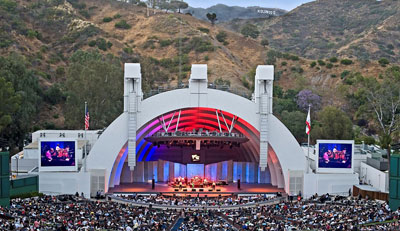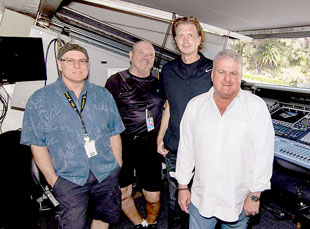With a summer season of performances from the likes of Yo-Yo Ma, Elvis Costello and Herbie Hancock closing, The Hollywood Bowl is able to assess the DiGiCo SD7 mixing consoles it has installed at FOH and monitors.
 Part of the benefit of the new consoles is the ability to run the installed PA system at 96kHz audio resolution. ‘At 96k, there are certain subtle differences that you pick up, such as the dynamic range of the highs and lows,’ says Paul Geller, the veue’s Production Director. ‘It also produces a very natural acoustic sound. It’s a great marriage between the DiGiCo console and the L-Acoustics loudspeaker system.’
Part of the benefit of the new consoles is the ability to run the installed PA system at 96kHz audio resolution. ‘At 96k, there are certain subtle differences that you pick up, such as the dynamic range of the highs and lows,’ says Paul Geller, the veue’s Production Director. ‘It also produces a very natural acoustic sound. It’s a great marriage between the DiGiCo console and the L-Acoustics loudspeaker system.’
The Hollywood Bowl’s core audio team includes Fred Vogler, Principal Sound Designer & Mixer for the Los Angeles Philharmonic, which, along with the Hollywood Bowl Orchestra, uses the Bowl as its summer home; Michael ‘Shep’ Sheppard, Head of Audio/Video; and Kevin Wapner, Assistant Audio/Video & Monitor mixer.
Vogler reports that the DiGiCo desks can comfortably handle even the largest productions: ‘We’re at 96k with 160-something inputs and it still sounds as pristine as with two channels. I think that a big part of the resolution we’re getting is the front end of that console. It’s got a lot of high quality mic pres, signal paths and processing. It’s wonderful to have that kind of front end and feed it out of an L-Acoustics speaker system on the back end.’
Vogler addresses the zoned speaker system via the SD7’s matrix outputs, separately feeding the main left/right hangs, including flown subwoofers, down fill and front fill speakers, subs and mid-high boxes on the deck, plus various audience fill speakers. On the input side, says Vogler, he typically creates groups: ‘I’ll have a string group, woodwinds, percussion, horns or brass, lead vocals or solo instrument group, a band group and an effects group. I like the conductor or the notes on the page to do the balancing. It doesn’t mean that my mix is static, but I don’t get too heavy-handed with moving things up or down.’
The FOH booth is equipped with several high-end reverb systems, but Vogler also makes use of the DiGiCo effects processes: ‘I use the tap delays and some of the onboard reverbs,’ he reports. The Hollywood Bowl shell interacts with instruments on the stage, so for orchestral performances, ‘only a sparing amount of reverb is required,’ he says. ‘I’ll pick one based on the piece of music or the need of a particular instrument.’

There is one DiGiCo feature that Vogler particularly favours on vocals, the DiGiTuBe: ‘I really like the tube emulation; I like the warmth that it adds, especially if you have a vocalist that’s a little on the harder sounding side, or someone who tends to scream more. It definitely rounds out that impact and makes it a little warmer and more engaging.
‘I also love the Dynamic EQ, where you can take a frequency band and put it into a compressor and apply it to every channel. You don’t have to take all the frequencies; you can just compress a band of frequencies. That’s a very handy feature.’
The two SD7s are on a single Optocore loop, with all of the DiGiCo DSP located on stage. ‘If I can’t see a conductor well and I need specific cues, I put the conductor cam on the console’s meterbridge screen. If I’m really bored I’ll put the monitor mixer on there,’ Vogler says.
The venue’s summer series is non-stop, featuring almost daily concerts by the LA Phil, the Hollywood Bowl Orchestra, guest performers and lease events – concerts staged by third-party promoters: ‘Because we’re doing one-offs we get one rehearsal, so there’s not a lot of time to fool around,’ says Vogler. ‘We have several console templates that Shep has organized: orchestra, orchestra loud, jazz and rock. We have the basic EQs and onboard as well as external processing figured out for each particular type of presentation or program. Mike puts those together, labels the boards and organizes the session templates.’
Vogler is still getting to grips with the full capabilities of the SD7: ‘It’s a very sophisticated board,’ he concedes. ‘I have a lot of flexibility in the way I can assign things or move things. I always chuckle when people ask me if I know what all the knobs and buttons do. I have to tell, them, no, but I’m working on it. I like the fact that I don’t know what every knob and button does. I’m still learning new things to do with it. It keeps me on my toes; I’m not bored using it. We’ve been very happy with it – and I’m eager to learn more.’














